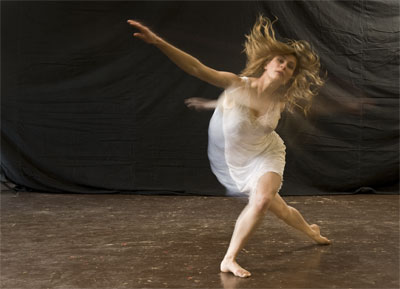 |
| Choreographer Lisa Phinney was inspired by the natural world in creating Analogy for Solid Bones. (Scott Munn Photo) |
You might think that atmospheric science and contemporary dance are strange bedfellows, but Analogy for Solid Bones makes a strong case for promoting their romance.
ﮊﮮ
AVﺝﻙﭺﻅﺎﺟ graduate and Halifax resident Lisa Phinney's newest dance was born from her love of the natural world. As a scientist for Environment Canada, but also a dancer and choreographer, Ms. Phinney has managed to combine these two seemingly different worlds to create a unique and moving interpretation of one of Canada's most treasured natural inhabitantsﻗthe loon.
With her cast of six dancers, Ms. Phinney paints a touching, subtle, and at times even comedic story. While the dancers move animalistically, in ways that at first seem strange and unfamiliar, it soon becomes apparent that they are far more human than animal. Desperately social, in need of attention, love, and acceptance, the loons move through the motions of their lives, at times in tandem, at other times in conflict with one another. They are awkward creatures, and yet possess a painful beauty that seems to mirror our own untidy and complicated lives. They go through the same motions and rituals as they seek mates and raise their young.
|
But as idealistic as it may seem, this piece is not naive to the effects of man on nature. The omnipresent narrator Ardyth Whynacht, a slam poet, sets an eerie, almost oppressive tone that jars the audience into the realization that this beautiful and secluded world is always under threat from a force bigger than what the loons can reckon with. There were times when it felt as though even by being spectators, we were invading a very private realm. Ms. Phinney makes a statement about the impacts of ecological deterioration; as the loons begin to exhibit signs of mercury poisoning, the story begins to feel more and more like a tragedy.
It is certainly a resonant message, and one that could potentially leave all spectators feeling like environmentalists. Ms Phinney, with her appreciation for ﻗtrans-disciplinaryﻗ expression, may be on to something here.
